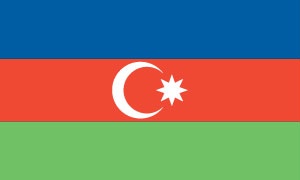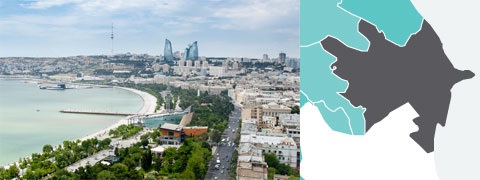Country assessments
Azerbaijan
- Details
- Country assessments
2013 sector transition indicators
Source: EBRD.
Note: Water – Water and wastewater; IAOFS – Insurance and other financial services; PE – Private equity.
Highlights
- Growth continues to be supported by ample hydrocarbon revenues. The authorities increasingly used oil and gas proceeds to expand the non-oil sector, build infrastructure and strengthen social protection. In 2012 almost two-thirds of all investment outlays in the economy were directed to the non-oil sector, which expanded by more than 9 per cent.
- The authorities are focusing on implementing policies to improve governance and reduce corruption. Some public services are now being provided through single-window service centres, which were created to make the provision of various government services – such as tax collection or registering companies – easier and more transparent.
- The Shah Deniz consortium chose the Trans-Adriatic Pipeline project to pump gas to Europe. The new pipeline, which is expected to be built by 2019, will transport Caspian gas from Turkey to Italy, via Greece and Albania, thus further diversifying export routes for Azerbaijan.
Key priorities for 2014
- Diversification of the economy remains a key priority for the authorities. To reduce dependence on the hydrocarbon sector, which is contracting, further progress should be made in improving the country’s business climate, reducing corruption and strengthening competition policy. Completion of the World Trade Organization accession negotiations and progress toward a free trade agreement with the European Union (EU) are two priorities that, if achieved, should increase international investment and encourage development of the non-oil sector over time.
- The authorities should continue to improve conditions for development of the financial and capital markets. Restructuring and transparent privatisation of the major state-owned bank – International Bank of Azerbaijan (IBA) – would help strengthen the banking sector and commercialise, and eventually unwind, state-directed lending. The Central Bank of the Republic of Azerbaijan should continue to improve the monetary and exchange rate policies framework, and further encourage de-dollarisation in the economy.
- The government should strengthen policies concerned with managing oil wealth. Present and future generations would benefit from the introduction of a fiscal policy rule that, in light of the limited time horizon for the extraction of hydrocarbons, would aim to smooth the intergenerational allocation of oil wealth and promote fiscal discipline during periods of high oil prices. Future public investment projects should be designed to increase growth potential, and to complement, rather than displace, private sector investments.
Macroeconomic performance
The pace of economic growth has been slow, due to the ongoing contraction of oil output. Although the decline in oil output (by 5.3 per cent in 2012 and 1.6 per cent in the first half of 2013) has been more than offset by the encouraging growth of the non-oil sector (by 9.7 per cent in 2012 and 10.9 per cent in the first half of 2013), overall output growth has remained subdued, compared to the boom of the pre-crisis period. Growth in the non-oil sector has been led by construction and services, and supported by expansionary fiscal and monetary policies. The Central Bank continues to maintain the policy of a stable exchange rate of the manat against the US dollar. Inflation was contained at around 1 per cent on average in 2012, but rose recently, to 2.2 per cent in August 2013. External debt remains low, and the public sector balance sheet is supported by a large oil fund of US$ 34.1 billion (or 49.5 per cent of GDP). The non-oil current account deficit remains very large, but exports of oil and gas continue to ensure that, overall, the current account remains in surplus and the exchange rate remains stable over the medium term.
Economic growth is likely to remain subdued over the medium term, as hydrocarbon output stabilises and the expansion of the non-oil sector slows. The oil sector is expected to recover somewhat in the period 2013-14, although some analysts believe that oil production may have reached its historic peak and will continue to decline. At the same time, gas extraction is expected to increase significantly in the coming years as the gas well, Shah Deniz II, comes on stream. Non-oil growth is likely to slow, unless the business environment improves significantly and conditions for foreign direct investment improve. Inflation is likely to rise moderately, as continued wage growth and capacity constraints in the non-oil sector put pressure on prices.
Risks to the outlook are largely related to the economy’s high reliance on the hydrocarbon sector. As the non-oil sector is dependent on public expenditures, the economy is vulnerable to volatility in energy prices or disruption in output. The external and public sectors are also vulnerable to changes in the oil price and future output developments. The financial sector may be vulnerable to a fall in real estate values and a potential increase in the volume of non-performing loans, as enterprise, mortgage and consumer loans may be affected by a contraction in the oil sector. The business environment, particularly outside of the oil and gas sectors, and potential external instability, are also sources of risk.
Major structural reform developments
Diversification of the economy has continued. A more diversified economy is among the authorities’ key priorities, outlined in the Vision 2020 programme finalised in December 2012. The main activities of the government in this area in the past year have included an intensification of infrastructure investments and the creation of high-tech and industrial parks. The high-tech parks are to be exempt from tax and duties for seven years, while the industrial parks may receive various discretionary benefits in the form of tax and customs incentives, reduced land lease payments, soft loans and simplified administrative procedures. However, the non-oil sector’s ability to generate self-sustaining growth without sizeable government support remains untested. The business environment outside of the oil and gas sector is improving, but remains difficult. The World Bank 2014 Doing Business report revealed that the country’s ranking has plateaued, at seventieth of 189 countries, with significant challenges in the areas of obtaining construction permits, getting electricity and cross-border trade. Consequently, foreign investment in the non-oil sector is very limited. The authorities are reviewing the country’s competition policy, and a draft competition code is undergoing public consultation. The code is expected to be considered by the parliament by 2014.
There are early signs of progress in reducing corruption and improving public services. Corruption remains one of the key barriers to development, and the country ranked one hundred and thirty-ninth of 176 countries in the 2012 Corruption Perceptions Index of Transparency International. However, the National Anti-Corruption Action Plan for 2012-15, adopted by a presidential decree in September 2012, provides for various improvements, including in legislation on criminal prosecution (such as provisions on witness protection) and a restriction of the immunity of judges suspected of corruption. In January 2013 the State Agency for Public Service and Social Innovations (ASAN) established its first single-window service centre in order to improve transparency, reduce bureaucracy and eliminate corruption in the provision of government services to citizens, such as in the issue of forms, the payment of taxes and for company registration. As a result, the number of procedures involved in starting a business was reduced from 30 to 7, while the costs of the procedures were halved. The ongoing e-government and e-signature initiatives may also reduce opportunities for corrupt practices.
Implementation of major infrastructure projects is ongoing. In November 2012 the parliament ratified an agreement with Turkey for the construction of the Trans-Anatolian gas pipeline (TANAP), which will carry Caspian gas from Turkey’s eastern border with Georgia to its western border with Europe. In June 2013 the Shah Deniz consortium announced that it had selected the Trans-Adriatic Pipeline (TAP) project instead of Nabucco West – the previously suggested alternative pipeline project – for its gas supply from Turkey to Europe. Supply terms for Caspian gas sales have been agreed with a number of companies from Greece and Italy, and equity acquisition deals with future TAP investors have been signed. During the first stage of the TAP project, the pipeline capacity is expected to reach 10 billion cubic meters of gas per year by 2019, and to possibly double later. Other large projects, such as the construction of the Baku-Tbilisi-Kars railway, connecting Azerbaijan and Turkey, the North-South rail corridor, linking Iran and Russia, and the construction of the new port near Baku, are ongoing. When finished, these projects should help strengthen the country’s role as a trade link between Europe and Asia.
The authorities continued to develop financial market regulation and infrastructure. Since the authorities introduced mandatory insurance of real estate and third-party liability insurance, and established a Compulsory Insurance Bureau, in 2011, the insurance market has grown strongly, albeit from a very low base. Insurers’ overall premiums increased by 61 per cent in 2012, and by a further 17 per cent in the first half of 2013. In 2013 the minimum capital requirement for insurance companies was increased from Manat 4 million to Manat 5 million (approximately US$ 6.5 million), resulting in greater financial sector stability. The Ministry of Finance is considering further increasing the minimum capital requirement, to Manat 10 million, in the coming years. The limit on foreign ownership in the combined capital of local insurers was increased, from 10 to 30 per cent, which may potentially open the market to foreign participants. Other steps to develop the financial market, such as the establishment of private credit bureaus, the expansion of mortgage lending, and the introduction of health and agriculture insurance, are under consideration. The forthcoming five-fold increase of the minimum capital requirement for Azerbaijani banks (to US$ 64 million), which will come into effect on 1 January 2014, is yet to result in a consolidation of the banking sector, but it has already led to substantial capital increases. However, little progress has been achieved in the restructuring of the IBA – the dominant state-owned bank, with a market share of around one-third of total banking system assets. The privatisation of the IBA was put on hold after the government supported the bank with a capital injection, which was completed in April 2013, and the Central Bank provided subordinated loans, in 2012.
The Central Bank has embarked on an initiative to promote non-cash payments. Under a draft proposal put forward in the middle of 2013, various incentives are being considered for increasing non-cash transactions, from the current very low level of 8 per cent, including exempting such payments from value-added tax and from customs duties for certain types of purchases made via the internet and paid electronically. The government plans to install point of sale terminals – now used primarily in the capital, Baku – throughout the country by 2016, and to equip all government agencies that receive taxes, stamp duties and fees with such terminals by the end of 2013.













